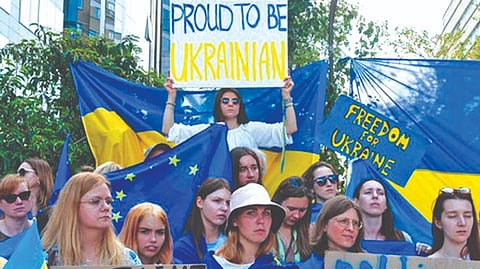

WASHINGTON: The European Union’s decision to grant EU candidate status to Ukraine and Moldova is historic , both for the former Soviet republics as well as for the EU. It is a turning point. Ukraine has been knocking on the EU’s door for about 20 years, but Brussels did not want to open it. The first signals were sent in the first years of the new millennium by authoritarian President Leonid Kuchma, who sought to maintain a balance between Russia and the West. The window of opportunity opened only after his departure and the victory of the Orange Revolution in Kyiv in 2004, when the pro-Western politician Viktor Yushchenko succeeded him.
But things didn’t work out. The democratic change in Ukraine took place in parallel with the first major EU enlargement to the east, which was accompanied by fears among many Western Europeans of an influx of cheap labor. Those fears did not materialise, but the EU was reluctant to continue expanding at the same pace. Brussels took a break, then came the financial crisis of 2009 and later the migration crisis of 2015. But the most important reason why Ukraine has not been allowed to get closer to the EU so far was the resistance of influential EU founding members. It suited them only too well that the enormous country formed a kind of buffer zone between the EU and Russia. Western Europe also feared that Ukraine’s accession would change the balance in favor of the countries of Eastern and Central Europe, with which Brussels already has a complicated relationship. It was not discussed publicly, but Western Europe long accepted that Ukraine would remain within Moscow’s sphere of influence, citing longstanding ties between “brother countries and peoples,” as EU officials put it. Ukrainians themselves underlined this in 2010 by electing as president the Russian-backed Viktor Yanukovych, whose pro-European rhetoric was just camouflage.
The EU hoped that Ukraine would be satisfied with its Neighborhood Policy and a free trade zone. This was a fatal, a historic mistake that indirectly contributed to triggering Russia’s current war against Ukraine: Europe did not want to integrate Ukraine, while Russia wanted to bring the ex-Soviet republic back under its control — at any cost.
But both the EU and Russia underestimated the determination of Ukrainians. As they demonstrated during two revolutions, in 2004 and 2014, Ukrainians value freedom and democracy above all. And, as they are also showing every day, they are ready to die for it. The Russian invasion of Ukraine has now forced the EU to correct its mistake. How consistent Brussels will be remains to be seen. Of course, there will be attempts to slow down this process, but a change of direction is no longer possible.
Candidate status for Ukraine and neighboring Moldova means that the era of buffer zones in the middle of Europe is coming to an end. Both post-Soviet countries are heading west, the countdown is on, the new Iron Curtain is lowering. It is the last stage of a reorganisation of the continent that began with the end of the Cold War.
And what of Georgia, which in 2003 became the first post-Soviet country to announce its Western orientation with the Rose Revolution? The decision on Georgia is also a signal to Ukraine and Moldova not to expect preferential treatment in the long run. Both countries will have to prove with deeds that they are ready for further integration and painful reforms. But there is no doubt — they will succeed and join the EU. And sooner than many think.
Visit news.dtnext.in to explore our interactive epaper!
Download the DT Next app for more exciting features!
Click here for iOS
Click here for Android